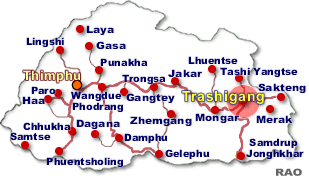 |
Bhutan Economy |
 |
Bhutan Information |
|
|
|
|
The
rice bowl
|
 |
|
Radhi
Phongmey lto Phongmey, Waaktsa Beeley lto Mala.
|
 |
It
is a local saying in Trashigang, loosely meaning "Radhi and Phongmey
have rice, but there is no rice to feed the children". It is meant
to point out that Radhi and Phongmey, Radhi more than Phongmey, cultivates
rice while the rest of the dzongkhag grows the popular staple grain, maize.
The children bit is a joke. |
"Even
as a child in the village I remember this saying," says Norbu Wangdi of
Bidung geog which lies on the opposite hill facing Radhi. "
When we looked
across, Radhi was an expanse of paddy fields." Apart from the well
known Burey weaves, Radhi is the biggest producer of rice in the
country's largest dzongkhag. In 2000, it produced about 8,64,495-kilogramme
of rice, from an official 512-acre of wet land.
A
study carried out last year showed that Radhi was the most profuse rice
producing geog in Trashigang followed by Phongmey and Bidung. Phongmey,
with 353-acre of wet land, produced an average 376.714 kg an acre last
year.
"By
all means, Radhi is the rice bowl of Trashigang,"
said a Trashigang dzongkhag official. "I buy my rice for the year from
Radhi farmers." So do a lot of others. Hotels in Trashigang serve Radhi
rice to customers; people travelling from Trashigang to other parts of
the country take Radhi rice as a gift.
| Tashigang
(Trashigang) town |
Radhi
geog, in north Trashigang, is a gentle slope of terraced paddy fields dropping
down from Tonglingphu and Phongmey in the north and north-west to the banks
of the river Yudiri chhu in the south and ending in the south-east where
the Rangjung urban settlement starts.
|
 |
In
winter the geog wears a forsaken look. Except for cattle feeding on the hacked paddy stumps on the terraces and the local transport service
truck from Trashigang roaring up the dusty feeder road there is not much activity.
At night, the dark looming hill is dotted with light bulbs that hang in
front of houses of the scattered villages in the geog.
But
come April and the Radhipas are busy turning its slopes and ridges
green with paddy. According to agriculture officials, production is highest
at 1,900-metre where an acre yields about 2.08 MT. At 1,435-metre it is
about 2.4 MT an acre, and 1.4 MT per acre at 1,250-metre. "In terms of
yield at the mid-altitude level (1500 to 1900-metre) rice production in
Radhi is significant and comparable to the Paro and Punakha valleys," says
the Trashigang district agriculture officer.
| Contributed
by KUENSEL, Bhutan's National Newspaper, 2006 |
 |
top
| Information on Bhutan |
 |
|




